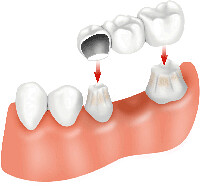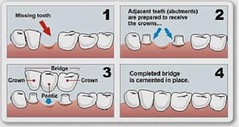What Are Dental Bridges?
 One of the most innovative types of dental solutions for missing teeth is dental bridges. Dental bridges literally “bridge” the gap between missing teeth, hence their name “dental bridges.” They allow patients to have false teeth placed where they are missing teeth without them having to undergo a surgical procedure. This solution for missing teeth is most ideal for those people who are missing two or more teeth side by side where no crown can be affixed by itself. Bridges can not only help patients restore their smiles, but they can also restore the function of the teeth by making it easier for them to speak and chew.
One of the most innovative types of dental solutions for missing teeth is dental bridges. Dental bridges literally “bridge” the gap between missing teeth, hence their name “dental bridges.” They allow patients to have false teeth placed where they are missing teeth without them having to undergo a surgical procedure. This solution for missing teeth is most ideal for those people who are missing two or more teeth side by side where no crown can be affixed by itself. Bridges can not only help patients restore their smiles, but they can also restore the function of the teeth by making it easier for them to speak and chew.
How Are Dental Bridges Made?
 Dental bridges require a crown to be placed over the teeth that are located on either side of the gap where the missing teeth are, and they are technically referred to as the abutment teeth. The first step of making dental bridges is to reduce the size of the tooth where the abutment will be placed. Next, the dentist studies the patient’s teeth to determine the appropriate size, shape and shade that the bridges should be crafted into to make sure they match the rest of the patient’s teeth. After all this information is gathered, then the mold is sent off to a dental lab where the technicians will construct the bridges, usually out of porcelain. Many patients choose to go with porcelain bridges, but other materials are available as well. Usually, dentists will provide patients with a temporary bridge to span the gap of missing teeth while the permanent bridges are being made.
Dental bridges require a crown to be placed over the teeth that are located on either side of the gap where the missing teeth are, and they are technically referred to as the abutment teeth. The first step of making dental bridges is to reduce the size of the tooth where the abutment will be placed. Next, the dentist studies the patient’s teeth to determine the appropriate size, shape and shade that the bridges should be crafted into to make sure they match the rest of the patient’s teeth. After all this information is gathered, then the mold is sent off to a dental lab where the technicians will construct the bridges, usually out of porcelain. Many patients choose to go with porcelain bridges, but other materials are available as well. Usually, dentists will provide patients with a temporary bridge to span the gap of missing teeth while the permanent bridges are being made.
How Are Dental Bridges Assembled? Assembling the dental bridges in patient’s mouths simply consist of placing them where the missing teeth are and then adjusting them for comfort and fit. Once the patient is comfortable with the position of the bridges within his or her mouth, the bridge can then be cemented into place for stability.
Caring for Dental Bridges? Just like patients have to care for their teeth and any other types of dental appliances, so do they have to care for their dental bridges if they want them to last to their full potential. First of all, patients should ensure that they visit their dentist at least once or twice as year to have their teeth professionally cleaned and examined. Additionally, they should attend any follow-up appointments after getting their dental bridges placed so that the dentist can ensure that the bridges are staying appropriately positioned. It’s not uncommon for a few adjustments to be needed after first getting dental bridges placed. Other measures that patients can take to care for their dental bridges include flossing and brushing regularly, avoiding biting down on hard objects that could break their bridges and avoiding extremely chewy foods that could dislocate their bridges or break them.
How Long Do Dental Bridges Last? Of course, any patient who’s considering investing in a dental appliance probably wants to know how long the appliances will last. With proper care and maintenance, dental bridges can last 15 years or even longer. In fact, when patients go to the dentists regularly and maintain good oral hygiene, it is quite common for bridges to last for at least a decade or longer.
References:
Colgate. “What Are Dental Crowns and Tooth Bridges?” Retrieved on February 23, 2016, from http://www.colgate.com/en/us/oc/oral-health/cosmetic-dentistry/bridges-and-crowns/article/what-are-dental-crowns-and-tooth-bridges.
American Dental Association. “Bridges.” Retrieved on February 23, 2016, from http://www.mouthhealthy.org/en/az-topics/b/bridges.
Colgate 300 Park Ave. New York, NY10022 212-310-2000 www.colgate.com